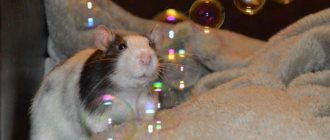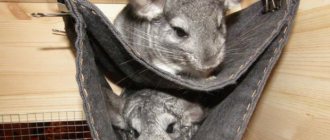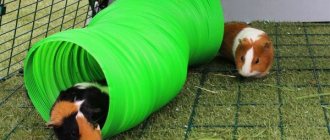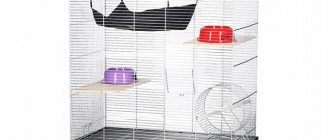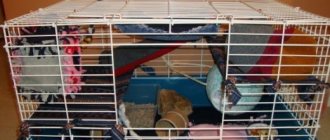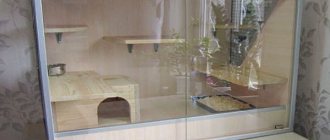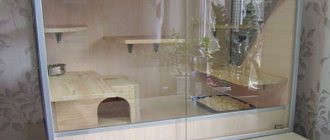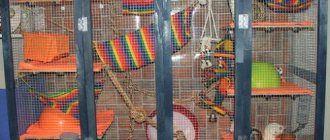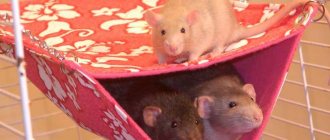How to set up a play area for rats
Rats need space to play freely. Unlike other small rodents, they cannot stay in their cage for long. There are people who allow rats to roam around the house, but this is usually a bad idea. However, creating a safe area for your pet to play is the best way to keep rats entertained without damaging furniture in your home.
- Remove anything from the area that could harm rodents.
When creating a play area, make sure electrical wires are hidden. They can hurt your rat. Also clear the area of any toxic substances or sharps. Choose a place away from people and other animals.
The best place to place a rat entertainment area is in the corner of the room or on a wooden floor. The main thing is to arrange the area away from important things that can be easily chewed by animals, and away from electrical outlets.
- Place the blanket on a flat surface to protect it from damage.
It's best to plan the play area on a raised surface, but you can install it on the floor as well. Rats have an instinctive tendency to chew things, so it is worth covering the table or floor with a blanket to protect the surface.
If you set up a play area on a table, you won't have to build a fence around the area because rats won't jump from heights. Base your choice on your pet's personality to decide whether to keep them free or build a barrier.
Create an entertainment area on the floor for easier monitoring of your pets. However, rats may start chewing your carpet if they chew through your blanket.
- Cut and glue flat cardboard panels of the same size.
Take a few boxes, arrange them, and cut them until you are left with at least a few dozen pieces of the same size. Use duct tape to cover the holes and smooth out the folding parts so that each panel is completely flat. Then line up the panels side by side and tape the edges to form one long flexible barrier.
- Place a cardboard barrier around your chosen area in a circle.
Making sure the barrier is secured to the blanket, surround the area with cardboard in a circle shape until the two ends meet. Clamp the ends together and double-check for any holes that could allow rats to slip through. Then cover these holes with tape and you are ready to start adding toys.
How to please your pet?
From such an abundance of materials you can create a large number of different toys and fun products; this is not a complete list of materials, so the quantity and quality of products differs only by your imagination. It is very important at the design stage of the toy to take into account all factors so that the rodent not only likes it, but is also safe.
Ramps, ladders and ropes are fun alternatives to regular cage slides
The rat is one of the most intelligent animals, so it cannot sit in one place, it needs to constantly do something. Then the pet will feel good, is in excellent shape and will confidently communicate with its owner. There are several models of different products, each of which is unique and fun in its own way. Let's look at the instructions for creating the best toys for rats.
Digging container
Previously, we looked at the features of this product, but we should consider in more detail the stages of creating a toy, because we need to take into account some features. Such a box can keep a rat occupied for several hours, and it brings the animal closest to its natural conditions. In addition, the rodent will not only be able to dig, but will also consume roots, grass and sprouted seeds. In the summer, the pet will be able to spend time in cool ditches, which he himself will make in this box. To create a product, you should perform the following algorithm of actions:
- You need to prepare a fairly large box; it is best to choose an eraser product, for example, a kitchen bowl.
- The box is half filled with clean soil.
- You should throw grain or birdseed into the soil, then water it with a small amount of water.
- Within a few days, the seeds will germinate, and after 7 days the harvest will be enviable.
- You need to place the box in a place where it can be easily removed.
- After this, you can put the rat in this box.
Article on the topic: How to stop a pet rat from biting: instructions
At first, the rodent will not understand what it needs to do, and will also be embarrassed to cause mischief, casting doubtful glances at the owner.
Soft tunnel
This is a very simple and easy to implement product, but you will still need to have basic knowledge and sewing skills. To implement a soft tunnel, you should perform the following algorithm of actions:
- It is necessary to prepare a piece of inexpensive fabric, for example, cotton or fleece.
- We cut out a piece from this material, the size of which is 35 centimeters in width and 1.5 centimeters in length; you do not need to strictly adhere to this size, focus on the dimensions of the finished product.
- Next, you need to proceed directly to creating a tunnel. A sewing machine is perfect for these purposes, although you can also use the manual method, although it will take a lot of time.
- If you have the appropriate skills, then you can add several more to one tunnel, as well as make separate rooms and all kinds of branches.
- Rings are cut out of a plastic bottle, which need to be secured at the ends of the tunnel, and if it is long, then in the middle. Thanks to such actions, the product will always be open.
Pets will love this toy; they will wander through the tunnel and hide if necessary. This product is able to imitate the natural habitat of rodents, because they always build a whole cold system underground. Making toys for rats with your own hands is not that difficult, the main thing is to show patience, responsibility and creativity.
Rat toys
There are many toys designed specifically for rats, such as:
- Wheels and balls.
Rat wheels are a great way for rodents to exercise and stay healthy. Be sure to choose a safe wheel that won't hit your rodent's legs or tail. Solid wheels are definitely preferable to wire mesh wheels. The optimal diameter for a rat wheel is 30 centimeters. It can be placed in a cage, as well as in a play area.
Small swords also support activity outside the cell. However, keep an eye on your pet when he is playing ball.
- Climbing toys.
Ladders, tubes, ropes, twigs, cement bird perches, hammocks and similar devices can provide numerous climbing activities for the animal. They are convenient to attach to the cage, but they are also great for the playground.
- Chew toys.
Rodents need toys that they can use to chew. They are needed to keep rats' teeth healthy as they grow and need to be worn down. Quality chew toys are made from rawhide, wood (no preservatives), or cardboard. Toilet paper cardboard, cardboard boxes, and egg cartons make great affordable rat teeth grinding toys.
What toys for rats can you make yourself? Features of material and product selection
Many people decide to get a pet, but not everyone wants to have a large animal, since they need to devote a lot of time to it, and it is also very difficult to maintain such a pet in an apartment. Therefore, an excellent solution would be to get a decorative rat, but this does not mean that the rodent does not require your attention and time. At first, the animal will behave warily and even aggressively, but when it gets used to its new home and its territory, and also understands that nothing threatens it, its behavior will return to normal. The pet will spend most of the day on its own; there are various toys for rats, with the help of which the rodent will be able to fill the lack of attention from the owner. Such products are sold in special pet stores, and you can also make them yourself with your own hands.
Water activities for rats
Pea fishing is a great water game for rats. Place a cloth in the entertainment area, then take a bag of frozen peas and place a handful in a shallow ceramic or glass bowl of cool water. Add some large, smooth rocks for your rat to climb on. Show the rats their new pool. Now you can watch them jump into the water and dive for peas, or sit on the edge playing with the peas with their front paws, or just lie in the water and eat the peas they retrieved.
Your water-loving rats will love the opportunity to swim and snack at the same time. And those who are afraid of water will be able to sit calmly on a rock or on the edge of a pool and catch peas floating by.
digging box
Most rats love to dig in the box. Take a small cat litter tray or other shallow plastic box and fill it halfway with plain sterilized potting soil (not treated with any chemicals or fertilizers and without additives such as vermiculite).
Plant some birdseed or grains and water them to allow the seeds to germinate and grow a little, then let your rats go into the box.
To minimize the mess, don't water the sprouts for a day or two before inviting your rats in, you can put it in a bathtub, or spread a tablecloth or newspapers around the box to reduce litter. Your rats will love to dig into the soil and snack on sprouts or seeds.
Maze for rats
You can build the following types of labyrinths:
- A labyrinth of pipes.
Fabric tubes are ideal for creating complex mazes for your rats. Go to your local hardware store for a variety of PVC pipes that are at least 2 inches wide. Connect corner pipes, straight pipes, and their connectors in any order to create a tunnel maze. You can also make fabric tunnels by cutting off the legs or sleeves of old clothes and stuffing them with toilet paper tubes.
However, PVC ones are better for rats that like to chew a lot, while a fabric tunnel allows you to keep an eye on where your rat is in the maze.
Simply separate the fabric tubes from each other when you are ready to remove the play area. You can create a different kind of maze the next time you release the rats.
- Labyrinth of boxes.
Rats love to climb and climb, so you can stack boxes to create a maze. But the structure must be strong enough to climb without collapsing under the weight of your rats. If you're feeling ambitious, try training your rat to jump through hoops, ramps, and other openings.
Use treats or moving objects to guide her through a route or maze. Rats will instinctively chase anything that moves quickly, so use string, feathers, or small crushed balls.
PROJECT MYSHKO - assembly instructions
For work we will need a lot of empty plastic bottles. Their number depends on the desired size of the future labyrinth. More bottles - a longer and more confusing labyrinth. You also need scissors, a sharp knife, a marker, tape or glue may come in handy.
Now we begin to create the first working module of our ultra-modern cybernetic mouse lair. To do this, draw two circles on one of the bottles, along which we will then cut out the gateway.
Pipe tunnel for rats
Rats and other rodents are accustomed to using and making tunnels in nature. Provide them with ready-made items to explore or let them make their own. Reinforced plastic or PVC tunnels can be placed in the play area or suspended from stainless steel hangers in the cage.
You can easily redo the tunnel if your rat gets bored with it. Another advantage of such devices is that the fabric is easy to clean. Be sure to choose a pipe that is large enough in diameter so that the rat cannot get stuck in it. Wood blocks can also be drilled into tunnels, which rats can expand through their natural tendency to chew.
Intellectual games for rats
Gathering and scavenging are natural behaviors of these rodents and should be a regular part of their foraging pattern. A food puzzle is an easy way to develop this behavior.
But the market for rat food puzzles is somewhat limited. However, toys designed for other small animals can easily be used. Make sure the toy is the right size: small enough that the rat can't get inside and get stuck, or large enough that he can maneuver it easily once inside.
Supervise all interactions with food puzzles to ensure your rat's safety. Use only foods recommended by your veterinarian and be sure to measure portion sizes. To get your rat interested in a toy or food puzzle, you can cover the outside of it with something edible. Cream cheese and yogurt can be used in small quantities to entice your rat to play with the toy. However, keep in mind that these foods have no nutritional value and should not form a significant portion of your rat's actual diet.
And remember that the edibles served in the food puzzle should be considered part of your rat's daily diet to maintain his healthy weight.
Cooperative games for rats
Rats can learn to play interactive games such as hide and seek and sack tug. When you hide behind a chair or sofa, your rat may look for you and become agitated if you suddenly appear. Paper bags intrigue some rats. They are attracted to the rustling sound they make when you scratch or wrinkle the material. Allow the rat to climb in and out of the bag, pounce on it, or sit inside while you pull it.
You don't need to buy expensive toys to keep your pet rat happy. Use items from your home to fill your rat's play area. You can also create your own food puzzle by filling an empty toilet paper roll with food and blocking both ends with crumpled paper.
Make your rat's cage more stimulating by hanging and hiding food in different places. To encourage exercise, consider a multi-level multi-story house, with treats available at each level. You can also use cardboard boxes to create areas for exploring and climbing.
Interesting examples
Papier-mâché house
You can make such an original beautiful house yourself. Inflate the balloon to the desired size. Next you will need glue, which must be made harmless by mixing water with flour. Strips of white paper are cut, each strip is dipped in prepared glue and placed on an inflated balloon. Once the entire ball is covered with several layers of paper soaked in glue, you can leave it for a while to allow the craft to dry completely.
After complete drying, the balloon can be burst and removed from the craft. Cut a large entry hole. You can also cut out additional doors and windows. You can make a small hole in the top to hang the house from the ceiling of the cage. You can fill such an original house with crumpled strips of fabric or paper to make the nest more cozy. Thus, you can make absolutely any houses of various shapes using different balls.
Denim stairs
To make a denim rope ladder, cut long strips from old jeans and twist them into long strips that will become the side main pieces for the ladder. Then make crossbars, thinner strips are also twisted and attached to the main strips.
